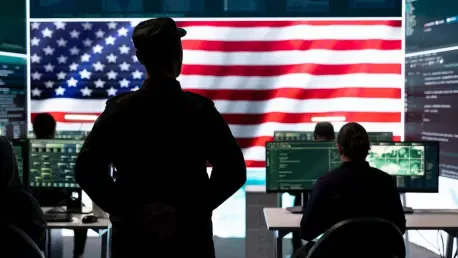Imagine a sprawling government agency, born from the urgent need to safeguard a nation after a devastating attack, now accused of becoming an unwieldy giant riddled with inefficiency and bias. This is the reality facing the Office of the Director of National Intelligence (ODNI), an entity tasked with coordinating U.S. intelligence efforts since its inception after 9/11. Today, under Director Tulsi Gabbard’s leadership, a bold restructuring dubbed “ODNI 2.0” is underway, slashing workforces and programs to redefine its mission. This roundup gathers diverse perspectives from policymakers, analysts, and industry observers to explore the implications of these sweeping reforms, aiming to provide a balanced view on whether this overhaul will strengthen national security or risk destabilizing a critical institution.
Why ODNI Faces a Dramatic Overhaul: Voices on the Need for Change
The origins of ODNI trace back to a post-9/11 push for better intelligence coordination, but over the years, its growth into a bureaucracy of around 1,500 staff has drawn sharp criticism for redundancy and overreach. Many observers, including Republican lawmakers, argue that the agency has strayed from its core purpose, becoming a symbol of bureaucratic bloat. A prominent sentiment among conservative analysts is that the time for a drastic reset has arrived, especially given public concerns over unauthorized leaks and perceived political agendas within intelligence circles.
On the other hand, some former intelligence officials caution against viewing ODNI solely as a problem to be downsized. They highlight its vital role in synthesizing data across agencies to prevent catastrophic oversights like those before 9/11. While acknowledging inefficiencies, these voices stress that reform must preserve the agency’s ability to connect critical dots in an increasingly complex global threat landscape, rather than focusing purely on cost-cutting or political realignment.
A third perspective emerges from think tank researchers who see the overhaul as a response to eroded public trust. They point to high-profile controversies, including past intelligence assessments clashing with political narratives, as fueling skepticism among citizens and elected officials alike. These analysts suggest that while transformation is necessary, the scale and speed of current plans under Gabbard’s direction could either rebuild confidence or deepen divisions, depending on execution and transparency.
Breaking Down ODNI 2.0: Diverse Opinions on Key Reforms
Workforce Reductions: Efficiency or Vulnerability?
One of the most headline-grabbing aspects of ODNI 2.0 is the plan to cut the workforce by over 40%, reducing staff to under 900 in the near term. Proponents, including certain GOP figures, praise this move as a long-overdue step to eliminate waste, projecting annual savings of $700 million. They argue that a leaner structure will sharpen focus on national security priorities, free from the drag of unnecessary personnel or duplicated roles.
Critics from within the intelligence community, however, express alarm at the depth of these reductions. Many seasoned professionals warn that slashing numbers so drastically risks losing institutional knowledge and expertise at a time when threats like cyber warfare and geopolitical rivalries are escalating. Their concern centers on whether a smaller ODNI can still effectively oversee and coordinate across the vast intelligence network without critical gaps emerging.
Policy analysts offer a middle ground, suggesting that while trimming excess is justifiable, the process must be strategic rather than sweeping. They advocate for targeted cuts that preserve core analytical and operational capacities while urging the administration to provide clear metrics on how national security outcomes will be maintained or improved. This balanced view underscores a broader debate on whether savings justify potential vulnerabilities.
Program Cuts and Clearances: Purging Bias or Silencing Dissent?
Another contentious element involves terminating programs like the External Research Council and Strategic Futures Group, accused of promoting partisan priorities, alongside revoking security clearances for 37 officials. Supporters of these actions, often aligned with the current administration, contend that such steps are essential to root out bias and ensure intelligence work serves national interests over personal or political agendas. They view these eliminations as a necessary purge of entrenched partisanship.
Opposition comes from civil liberties advocates who argue that these moves could chill independent thought within ODNI. They worry that revoking clearances and dismissing leaders—such as top National Intelligence Council officials over disputes with administration claims—sets a precedent for punishing dissent rather than fostering rigorous, unbiased analysis. This perspective raises questions about the line between accountability and suppression.
A more nuanced take from academic circles focuses on the long-term impact on agency culture. Scholars in intelligence studies suggest that while removing programs perceived as redundant or biased may streamline operations, it risks alienating talent and discouraging candid reporting. They emphasize the need for mechanisms to protect analytical integrity, warning that without such safeguards, ODNI could become an echo chamber rather than a source of truth.
Deep State Distrust: Fueling the Reform Agenda
Skepticism toward the intelligence community, particularly from the Trump administration, has been a driving force behind ODNI 2.0. Many administration allies point to historical tensions, such as findings on foreign election interference, as evidence of a “deep state” undermining elected leadership. This narrative frames the reforms as a critical effort to reclaim control and align intelligence with executive priorities.
Contrasting this, several retired intelligence officers argue that labeling the community as inherently untrustworthy oversimplifies a complex system. They acknowledge past missteps but stress that distrust can erode morale and deter experienced professionals from serving, potentially weakening national defense. Their view calls for rebuilding bridges rather than burning them through aggressive restructuring.
Public policy experts add a broader lens, noting that this atmosphere of suspicion could reshape how intelligence operates in relation to political power. They question whether reforms driven by distrust might prioritize loyalty over objectivity, potentially compromising the very independence needed for credible assessments. This concern highlights a pivotal tension at the heart of the current shake-up.
GOP Alignment: Political Strategy or Genuine Reform?
Gabbard’s initiative aligns closely with Republican priorities, evidenced by endorsements from figures advocating for a streamlined ODNI capped at fewer than 700 employees. Supporters within conservative policy circles see this synergy as a strength, arguing that it ensures reforms have the political backing needed to overcome entrenched resistance and deliver lasting change focused on accountability.
Skeptics from nonpartisan watchdogs, however, caution against viewing this alignment as purely reformist. They suggest that strong GOP support might reflect a desire to mold ODNI into a tool for administrative control rather than an independent entity. This perspective raises alarms about the agency’s future autonomy and its ability to provide unfiltered intelligence in politically charged contexts.
A third opinion from legislative analysts examines how this political recalibration fits into broader GOP-driven government reforms. They note that while partisan backing can accelerate change, it also risks polarizing the intelligence community’s mission, potentially alienating bipartisan support needed for sustainable policy. This analysis prompts reflection on whether ODNI 2.0 serves national interest or a narrower ideological vision.
Key Takeaways from the ODNI 2.0 Debate
Amid the flurry of opinions, several core themes emerge from discussions on ODNI 2.0, including the push for efficiency through massive workforce cuts and the elimination of programs deemed partisan. Advocates across various sectors agree that rebuilding public trust is a priority, though they differ on methods—some champion drastic measures, while others urge caution to protect national security capabilities. This diversity of thought underscores the complexity of reforming an agency central to U.S. safety.
Another standout insight is the role of political dynamics in shaping these changes. While alignment with Republican goals provides momentum, it also fuels concerns among critics about the erosion of independence in intelligence work. Observers from multiple backgrounds stress that transparency in implementation will be crucial to balancing cost-saving objectives with the preservation of analytical rigor.
Finally, the debate reveals a shared recognition of the need for dialogue between ODNI, Congress, and the public to navigate this transformation. Stakeholders are encouraged to monitor public reports and congressional hearings for updates on how these reforms unfold. Staying informed through accessible government resources can help clarify whether the restructuring achieves its stated aims without compromising critical functions.
Reflecting on a Pivotal Moment in Intelligence History
Looking back, the discourse surrounding ODNI 2.0 captured a historic clash of ideals—efficiency versus expertise, accountability versus independence, and trust versus suspicion. The varied perspectives from policymakers, former officials, and analysts painted a picture of an agency at a crossroads, grappling with both internal challenges and external political pressures. Each voice contributed to a fuller understanding of the stakes involved in reshaping a cornerstone of national security.
Moving forward, a practical step would be to establish independent oversight mechanisms to evaluate the impact of these reforms on ODNI’s effectiveness over the coming years, starting from 2025. Engaging bipartisan commissions to assess outcomes could mitigate risks of politicization while ensuring that cost savings do not undermine mission-critical work. Additionally, fostering open channels for current and former intelligence professionals to share insights anonymously might help address cultural and operational concerns without fear of reprisal. These actions offer a path toward balancing the bold vision of reform with the enduring need for a robust, credible intelligence apparatus.









